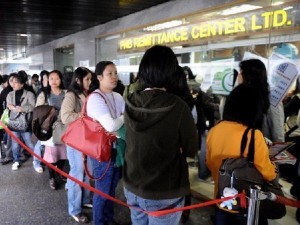Remittances grew slowly in March

Filipino domestic helpers line up to send money at a remittance center in the central district of Hong Kong in this 2008 file photo. The Bangko Sentral ng Pilipinas on Wednesday, May 15, 2013, reported that remittances reached $1.75 billion in March, up 3 percent from the $1.7 billion posted in the same month last year. The growth rate was the slowest since September 2009, BSP data showed. AFP/TED ALJIBE
The rate of rise in remittances registered its slowest pace in three and a half years amid the challenges now facing the global economy.
According to analysts, the slowdown in March is a reminder that remittances may eventually reach a plateau over the medium term due to a host of factors, such as the number of overseas Filipino workers (OFWs) now approaching critical mass, the continuing problems of most advanced economies, and the rise in the number of jobs being generated in the country brought on by improving business sentiment.
The Bangko Sentral ng Pilipinas on Wednesday reported that remittances reached $1.75 billion in March, up 3 percent from the $1.7 billion posted in the same month last year. The growth rate was the slowest since September 2009, BSP data showed.
Cumulative remittances in the first quarter amounted to $5.11 billion, up 5.6 percent from the $4.84 billion of the same period last year.
The biggest sources of remittances were the United States, Canada, Saudi Arabia, the United Kingdom, United Arab Emirates, Singapore and Japan.
Article continues after this advertisement“The deceleration in the growth rate of remittances in March may … continue. This is because [the Philippines] may be reaching the limit of [its] ability to supply labor to the overseas market,” Ernesto Pernia, economics professor from the University of the Philippines, told the Inquirer.
Article continues after this advertisementPernia echoed most economists’ sentiment that the Philippines should start looking for other sources of dollars to keep its gross international reserves (GIR) healthy.
Currently, remittances and foreign investments in the business process outsourcing sector are the main drivers of the GIR. Pernia said the country should fully develop its tourism industry, and implement measures that would attract foreign direct investments in key sectors.
“The country [must] realize that continuing to rely on remittances would be imprudent,” Pernia said, warning that the slowdown should serve as a wake-up call. Also, the Philippines needs the manpower to boost the manufacturing sector.
According to estimates, there are over 10 million Filipinos based overseas.
The BSP said the number of OFWs may rise further in the months ahead. It cited a report from the Philippine Overseas Employment Administration where overseas job orders reached 292,483 in the first four months of the year. The job orders came mostly from Saudi Arabia, the United Arab Emirates, Qatar, Hong Kong and Kuwait.